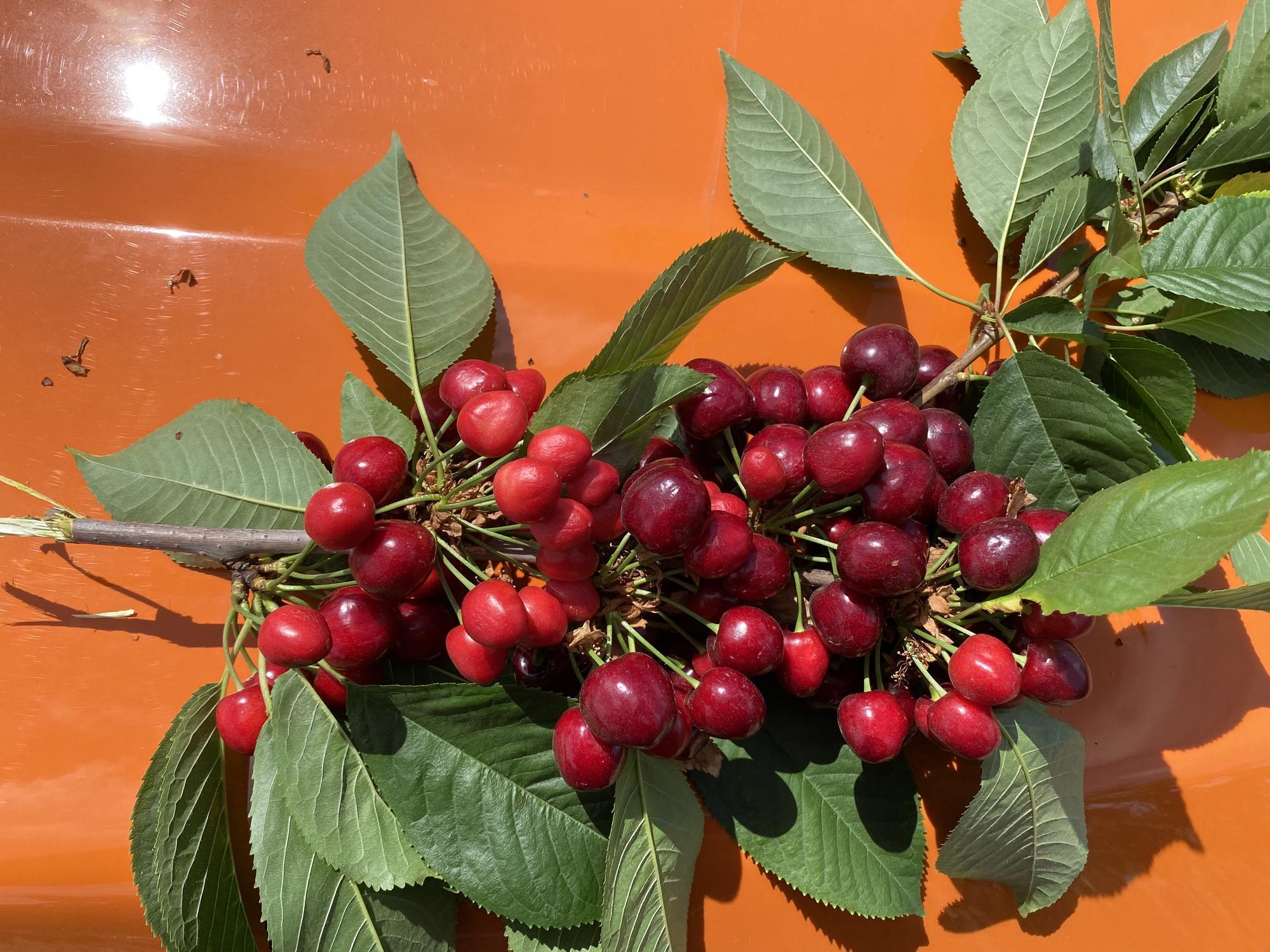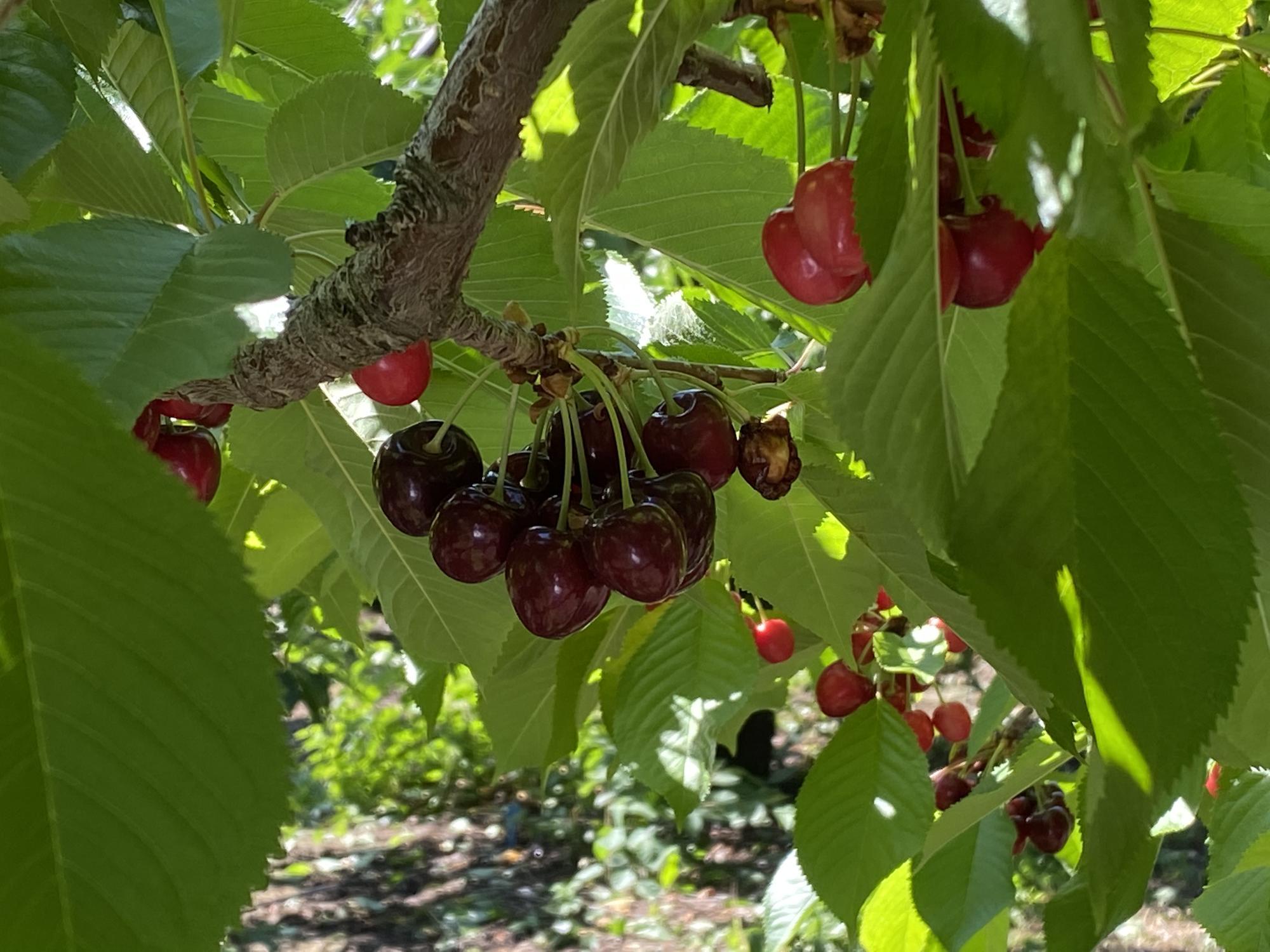Introduction
X-disease, caused by the phytoplasma ‘Candidatus Phytoplasma pruni’, has been documented in the Pacific Northwest since the early 1930s. Unfortunately, X-disease has become a cyclic problem on the West Coast as outbreaks of X-disease emerge every 20 years or so. Understanding X-disease and identifying and removing infected trees will help break this cycle.
Sweet cherry trees infected with X-disease produce unmarketable little, pointed fruit that does not ripen. The X- disease phytoplasma can rapidly spread from tree to tree through leafhoppers and occasionally by root grafts. Once infected, a tree may not show symptoms for two years, but it will be contagious. X-disease can eventually kill an infected tree.
X-disease is an economically significant disease of sweet cherries. The 1931 X-disease outbreak in Napa and Sonoma counties in California destroyed the sweet cherry industry in that region. The Rogue Valley, Oregon, cherry industry suffered a similar fate in the 1950s. A later outbreak in California demonstrated that tree removal is the best way to reduce new X-disease infections. Since X-disease cannot be cured, reducing new infections in your orchard requires prompt detection and tree removal.
This publication will help orchardists and field representatives identify X-disease-infected trees, remove X-disease- infected trees and control infection in orchards confidently and efficiently.
Symptoms
The most noticeable symptom of X-disease is cherries that are poorly flavored (often bitter), small, pale-red to greenish-white and pointed or flat-sided at harvest. These cherries do not ripen and are often interspersed among normal-looking fruit. Symptoms usually start on one branch before progressing throughout the tree in subsequent years. As the infection progresses for four or more years, canopy development appears sparse due to reduced limb growth and small leaves. The crop load will be reduced.
Looking for symptoms
Symptoms are most noticeable as fruit matures — from two weeks before harvest to postharvest when normal fruit is mature. Look for two or more symptoms: small fruit; pointed fruit; pale color compared to other fruit on the tree (pink or yellow is common); dull, blotchy skin; and bitter or tasteless fruit. Two or more of these symptoms suggest that X-disease is likely. Small, unmarketable cherries are commonly confused with X-disease-infected fruit, but small cherries will ripen normally and have good flavor and shape. Small cherries result from poor irrigation practices, overcropping or diseases like bacterial canker.
Susceptibility
All sweet cherry cultivars, including early cultivars like ‘Chelan’, are susceptible to X-disease. However, symptoms may vary. Light-colored cultivars, such as ‘Royal Ann’, and blush cultivars, such as ‘Rainier’, that are infected with X-disease tend to produce little, pale-yellow fruit interspersed among normal-appearing fruit (see Figure 1). Infected dark red cultivars, including ‘Sweetheart’ and ‘Bing’, produce little, pale red, dull and pointed fruit interspersed among normal-looking fruit (see figures 2 and 3). Two weeks before harvest, infected dark red cultivars may begin to exhibit symptoms. Little, light yellow or pink pointed fruit will be intermixed among normally developing fruit (See Figure 4).
Symptoms of X-disease infection also vary among rootstocks. For instance, X- disease-infected susceptible rootstocks such as ‘Mazzard’ and ‘Gisela 12’ can live for several years before symptomatic limbs become a noticeable problem and trees are removed. In contrast, the hypersensitive rootstock ‘Mahaleb’ will decline rapidly after infection. Look for symptoms of X-disease infection throughout your orchard blocks, independent of variety and rootstock.
Transmission
There are two main modes of X-disease transmission in the orchard: leafhoppers and root-grafting.
Leafhoppers
Several native leafhoppers transmit the phytoplasma, including Colladonus montanus, C. reductus, C. geminatus, Fiebriella florii, and Scaphytopius acutus, Paraphlepsius irroratus, and Euscelidius variegatus. E. variegatus appears to be the most common species found in The Dalles in Oregon. There are thousands of species, and many cannot be positively identified in the field, so monitoring for specific species is not recommended.
Leafhoppers survive by eating many different species of plants, some of which can be reservoirs or host plants for the X-disease phytoplasma. These plants include sweet cherry, peach, chokecherry, bitter cherry, mallow, clover, sweet clover and dandelion. Some potential reservoirs, such as chokecherry and bitter cherry, have not proven to be a problem in the Pacific Northwest. After feeding on an infected host plant, the pathogen multiplies within the insect and migrates from the stomach to the salivary glands. This process can take from three to five weeks. Once in the salivary gland, the insect can pass the phytoplasma to additional plants with every feeding.
Controlling insects as disease vectors is more complicated than controlling insects as pests. Relatively few insects can spread pathogens throughout your orchard. This means you can’t rely solely on vector control to reduce virus and phytoplasma infection in your orchard.
Root-grafting
X-disease can spread from tree to tree through root grafting. Root grafting occurs when thick roots press against each other underground. Eventually, the pressure between the roots causes the cambia of each tree root to fuse together. These two single trees now behave as one tree, sharing vascular fluids that contain water, nutrients and the X-disease phytoplasma if one tree is infected. Root-grafting has not been thoroughly researched in cherry trees or orchards, and most of our understanding is based on forest data. Trees in the forest are more likely to root-graft if they are spatially close and the roots are sufficiently large. Cherry trees are probably more likely to root-graft when trees are older and have a greater number of large, thick roots.
Management
Disease management includes early identification and removal of infected trees, monitoring and managing vectors, planting pathogen-free trees and managing alternative hosts.
Scout each orchard block when the fruit is mature or nearly mature. Look carefully at all sides of every tree. Train pickers and checkers to spot symptoms of X-disease. If you identify a tree with X disease symptoms, look for nearby trees with similar symptoms. Conspicuously mark trees with tree-marking spray paint or flagging tape. You may also want to record the GPS coordinates of the tree using your phone or a hand-held GPS. These steps will help you find the infected tree after harvest and scout nearby trees in the future.
X-disease can spread rapidly, so remove symptomatic trees quickly, preferably during the growing season. Since X-disease is transmitted through root-grafting, apply an appropriately labeled herbicide, such as glyphosate, to the stump, following the “cut stump treatment” instructions described in the label. This practice is most effective when the tree is still actively growing after harvest. The cut stump herbicide treatment aims to identify root-grafted trees for removal and prevent symptomatic trees that have been removed from growing suckers. Suckers can harbor the X-disease phytoplasma after the tree has been removed. Following treatment of the stump, neighboring root-grafted trees that exhibit herbicide damage should also be removed. These sucker shoots and root-grafted trees harbor the X-disease and can spread the phytoplasma in the orchard. This will further reduce potential disease inoculum in the orchard.
Nurseries in Washington, Oregon and California are not testing for the full range of viruses and phytoplasmas. In Oregon, virus-free certification is a voluntary program focusing on prunus necrotic ringspot virus (PNRSV) and prune dwarf virus (PDV). Thus, X-disease-infected material may be present, even in certified virus-free plant material. Talk to nurseries about their X-disease identification programs. Do not top work or graft with scions where X-disease is present. Avoid collecting cherry bud wood from areas in Oregon and Washington where X-disease is present.
Reducing leafhopper numbers will decrease the probability of spreading the phytoplasma. However, relying on vector management as your main X-disease mitigation strategy won’t eradicate X-disease from your orchard. Leafhoppers are good fliers and can move into the orchard from outside habitats throughout the year. Research in the 1980s in California showed that tree removal is the best way to manage X-disease. Focus leafhopper management on the early season and postharvest periods when populations are highest. Rotate between pesticide groups to prevent resistance. For organic orchards, Surround (kaolin clay) and reflective cloth (Extenday) could prevent or reduce feeding activity. Since you will not eradicate leafhoppers from your orchard and the surrounding area, removing infected trees is the best way to prevent the spread of X-disease.
Finally, keep your orchard tidy. Remove debris that leafhoppers can hide under. Keep your drive row well-mowed and maintained to reduce habitat and resources where leafhoppers develop. Suppress and control broadleaf weeds leafhoppers feed on. Remove alternative hosts, such as peach, chokecherry and bitter cherry, from within a 500-foot radius of your orchard. Remove cherry tree root suckers, as these are also an easily accessible food source for leafhoppers. Talk to your neighbors about their X-disease control strategies and work together to remove all infected trees.
Sampling for laboratory analysis
The X-disease phytoplasma can be identified in the lab using molecular diagnostic techniques. However, diagnostics are frequently unnecessary since X-disease can be diagnosed in the field by looking for small, pointed or pale fruit or fruit with dull, blotchy skin and bitter or tasteless flavor. If the tree has fruit with two or more symptoms or is in an orchard where numerous trees have been diagnosed with X-disease, it is possible to forgo testing since the tree is likely infected with X-disease. Your local Extension faculty can help you confidently identify X-disease by looking at mature fruit at harvest time. Sometimes symptoms are not apparent due to subtle symptoms, early infection symptoms, bacterial canker infection or environmental stress. In these circumstances, molecular diagnosis may be necessary.
Collect four 5-inch cuttings, including leaves and fruit stems, for molecular diagnostics, from symptomatic branches at harvest time through mid-August. Do not send old, dry leaves and stems, which are more likely to yield a false-negative result than fresh tissue. Try to sample early in the week if you are mailing your samples. Place the cuttings in a bag that is clearly labeled with your orchard name and the cherry variety and rootstock. Keep your sample as fresh as possible by storing it in the refrigerator until you send it to the lab. The Oregon State University Plant Clinic is currently testing for both X-disease and little cherry virus. Submit samples to the lab using the appropriate form (https://bpp.oregonstate.edu/plant-clinic/submit-sample/how-submit-plant…). Be sure to specify which diagnostic tests should be completed on your form. If mailing your samples, select an option that will deliver your samples within two or three days.
Mail your samples to:
OSU Plant Clinic
4120 Cordley Hall
2701 SW Campus Way
Corvallis, OR 97331-2903
Washington State University has compiled a list of laboratories (http://treefruit.wsu.edu/labs-lchv2-xdp/) in the Pacific Northwest capable of testing for X-disease and little cherry virus.
Use pesticides safely!
- Wear protective clothing and safety devices as recommended on the label. Bathe or shower after each use.
- Read the pesticide label—even if you’ve used the pesticide before. Follow closely the instructions on the label (and any other directions you have).
- Be cautious when you apply pesticides. Know your legal responsibility as a pesticide applicator. You may be liable for injury or damage resulting from pesticide use.






